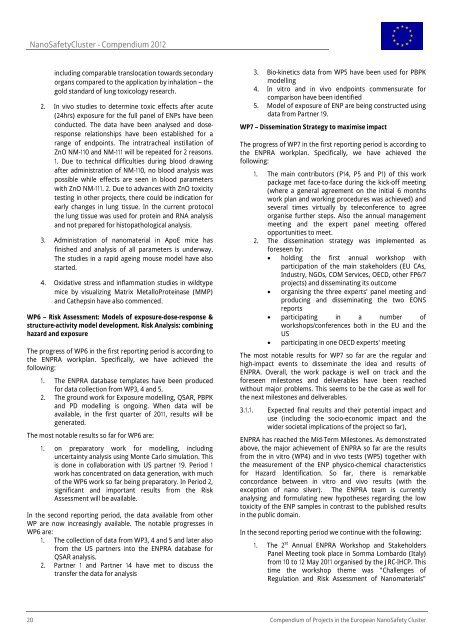Timing, hosts and locations of (grouped) events of NanoImpactNet
Timing, hosts and locations of (grouped) events of NanoImpactNet
Timing, hosts and locations of (grouped) events of NanoImpactNet
Create successful ePaper yourself
Turn your PDF publications into a flip-book with our unique Google optimized e-Paper software.
NanoSafetyCluster - Compendium 2012<br />
including comparable translocation towards secondary<br />
organs compared to the application by inhalation – the<br />
gold st<strong>and</strong>ard <strong>of</strong> lung toxicology research.<br />
2. In vivo studies to determine toxic effects after acute<br />
(24hrs) exposure for the full panel <strong>of</strong> ENPs have been<br />
conducted. The data have been analysed <strong>and</strong> doseresponse<br />
relationships have been established for a<br />
range <strong>of</strong> endpoints. The intratracheal instillation <strong>of</strong><br />
ZnO NM-110 <strong>and</strong> NM-111 will be repeated for 2 reasons.<br />
1. Due to technical difficulties during blood drawing<br />
after administration <strong>of</strong> NM-110, no blood analysis was<br />
possible while effects are seen in blood parameters<br />
with ZnO NM-111. 2. Due to advances with ZnO toxicity<br />
testing in other projects, there could be indication for<br />
early changes in lung tissue. In the current protocol<br />
the lung tissue was used for protein <strong>and</strong> RNA analysis<br />
<strong>and</strong> not prepared for histopathological analysis.<br />
3. Administration <strong>of</strong> nanomaterial in ApoE mice has<br />
finished <strong>and</strong> analysis <strong>of</strong> all parameters is underway.<br />
The studies in a rapid ageing mouse model have also<br />
started.<br />
4. Oxidative stress <strong>and</strong> inflammation studies in wildtype<br />
mice by visualizing Matrix MetalloProteinase (MMP)<br />
<strong>and</strong> Cathepsin have also commenced.<br />
WP6 – Risk Assessment: Models <strong>of</strong> exposure-dose-response &<br />
structure-activity model development. Risk Analysis: combining<br />
hazard <strong>and</strong> exposure<br />
The progress <strong>of</strong> WP6 in the first reporting period is according to<br />
the ENPRA workplan. Specifically, we have achieved the<br />
following:<br />
1. The ENPRA database templates have been produced<br />
for data collection from WP3, 4 <strong>and</strong> 5.<br />
2. The ground work for Exposure modelling, QSAR, PBPK<br />
<strong>and</strong> PD modelling is ongoing. When data will be<br />
available, in the first quarter <strong>of</strong> 2011, results will be<br />
generated.<br />
The most notable results so far for WP6 are:<br />
1. on preparatory work for modelling, including<br />
uncertainty analysis using Monte Carlo simulation. This<br />
is done in collaboration with US partner 19. Period 1<br />
work has concentrated on data generation, with much<br />
<strong>of</strong> the WP6 work so far being preparatory. In Period 2,<br />
significant <strong>and</strong> important results from the Risk<br />
Assessment will be available.<br />
In the second reporting period, the data available from other<br />
WP are now increasingly available. The notable progresses in<br />
WP6 are:<br />
1. The collection <strong>of</strong> data from WP3, 4 <strong>and</strong> 5 <strong>and</strong> later also<br />
from the US partners into the ENPRA database for<br />
QSAR analysis.<br />
2. Partner 1 <strong>and</strong> Partner 14 have met to discuss the<br />
transfer the data for analysis<br />
3. Bio-kinetics data from WP5 have been used for PBPK<br />
modelling<br />
4. In vitro <strong>and</strong> in vivo endpoints commensurate for<br />
comparison have been identified<br />
5. Model <strong>of</strong> exposure <strong>of</strong> ENP are being constructed using<br />
data from Partner 19.<br />
WP7 – Dissemination Strategy to maximise impact<br />
The progress <strong>of</strong> WP7 in the first reporting period is according to<br />
the ENPRA workplan. Specifically, we have achieved the<br />
following:<br />
1. The main contributors (P14, P5 <strong>and</strong> P1) <strong>of</strong> this work<br />
package met face-to-face during the kick-<strong>of</strong>f meeting<br />
(where a general agreement on the initial 6 months<br />
work plan <strong>and</strong> working procedures was achieved) <strong>and</strong><br />
several times virtually by teleconference to agree<br />
organise further steps. Also the annual management<br />
meeting <strong>and</strong> the expert panel meeting <strong>of</strong>fered<br />
opportunities to meet.<br />
2. The dissemination strategy was implemented as<br />
foreseen by:<br />
• holding the first annual workshop with<br />
participation <strong>of</strong> the main stakeholders (EU CAs,<br />
Industry, NGOs, COM Services, OECD, other FP6/7<br />
projects) <strong>and</strong> disseminating its outcome<br />
• organising the three experts' panel meeting <strong>and</strong><br />
producing <strong>and</strong> disseminating the two EONS<br />
reports<br />
• participating in a number <strong>of</strong><br />
workshops/conferences both in the EU <strong>and</strong> the<br />
US<br />
• participating in one OECD experts' meeting<br />
The most notable results for WP7 so far are the regular <strong>and</strong><br />
high-impact <strong>events</strong> to disseminate the idea <strong>and</strong> results <strong>of</strong><br />
ENPRA. Overall, the work package is well on track <strong>and</strong> the<br />
foreseen milestones <strong>and</strong> deliverables have been reached<br />
without major problems. This seems to be the case as well for<br />
the next milestones <strong>and</strong> deliverables.<br />
3.1.1. Expected final results <strong>and</strong> their potential impact <strong>and</strong><br />
use (including the socio-economic impact <strong>and</strong> the<br />
wider societal implications <strong>of</strong> the project so far),<br />
ENPRA has reached the Mid-Term Milestones. As demonstrated<br />
above, the major achievement <strong>of</strong> ENPRA so far are the results<br />
from the in vitro (WP4) <strong>and</strong> in vivo tests (WP5) together with<br />
the measurement <strong>of</strong> the ENP physico-chemical characteristics<br />
for Hazard Identification. So far, there is remarkable<br />
concordance between in vitro <strong>and</strong> vivo results (with the<br />
exception <strong>of</strong> nano silver). The ENPRA team is currently<br />
analysing <strong>and</strong> formulating new hypotheses regarding the low<br />
toxicity <strong>of</strong> the ENP samples in contrast to the published results<br />
in the public domain.<br />
In the second reporting period we continue with the following:<br />
1. The 2 st Annual ENPRA Workshop <strong>and</strong> Stakeholders<br />
Panel Meeting took place in Somma Lombardo (Italy)<br />
from 10 to 12 May 2011 organised by the JRC-IHCP. This<br />
time the workshop theme was "Challenges <strong>of</strong><br />
Regulation <strong>and</strong> Risk Assessment <strong>of</strong> Nanomaterials"<br />
20 Compendium <strong>of</strong> Projects in the European NanoSafety Cluster






